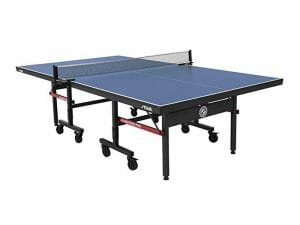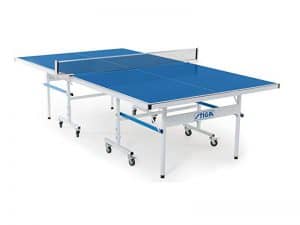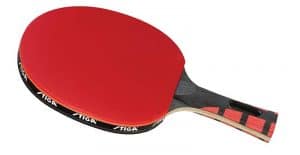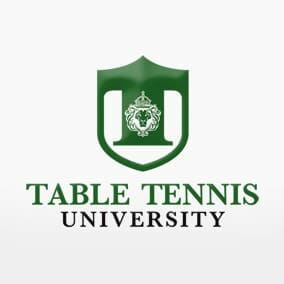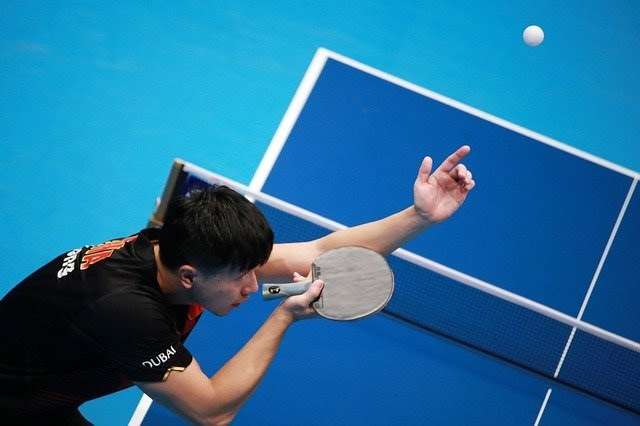How To Choose A Ping Pong Table: A Buyer’s Guide
- Alex Horscroft
- Last updated
Here at Ping Pong Ruler, we know it can be overwhelming to pick a new table tennis table. There are so many features to look for, some essential, and others just “nice-to-haves.”
What you need will depend on your circumstances and preferences, but we’ll try to look at all the different important features and how they will affect your game.

Table of Contents
Indoor vs Outdoor Tables. What’s the Difference?
The first question to ask yourself when buying a ping pong table is: where do you plan on putting it? Do you plan on putting it in your home in a games room? Or maybe you plan on putting it out in the garden, on the porch, or in the garage. A table tennis table can be pretty big, so you need to consider the best place to keep it. You can get tables made specifically for indoors or outdoors, or even ones that double up as indoor-outdoor tables, depending on the time of year.
Indoor Table Tennis Tables
If you’re going to keep your table inside, you’ll want to look for specific indoor features, like easy fold-up for compact storage. You might also want to look for one with wheels, so you can move it around when you’re not using it.
Expect indoor tables to have a more consistent and uniform bounce than outdoor ones that cost a similar amount. This is because outdoor tables have a weather-resistant material that directly affects how well the table tennis ball bounces off of the table’s surface.
Therefore, expect an indoor table tennis table to be equal to or better than the best outdoor table tennis tables in the same price range in playing quality. Indoor tables are not made for outdoor use and shouldn’t be left in the rain, ever.
Outside Table Tennis Table Features
If outside is your best option, you’ll want to get a table built to be kept outdoors or in a garage. The best outdoor ping pong tables are generally sturdier and have larger casters and a simplistic set-up system. Their frames and table legs are usually made with rust-proof quality materials to help them last longer and keep their strength. The playing surface is usually made with a waterproof material to stop it from losing its shape and warping when it gets wet.
Even if you plan on keeping it in your garage, you might be better off with an outdoor table to combat humidity and moisture, the worst enemies of a table tennis table!

Unfortunately, because of the additional materials required to make a weatherproof table, outdoor ping pong tables are generally more expensive than indoor models. So even though their bounce won’t be as good as on indoor tables in the same cost range, they can still provide you with a high-quality game. And you get to play table tennis in the sun — you can’t beat that!
To sum up, don’t put an indoor table outside while it’s raining or leave it in an area with high humidity for extended periods, as either scenario can cause it to warp and eventually ruin. Some Floridians have even mentioned that the high humidity from their natural climate caused their tables to warp!
Important Features to Consider
Now that we’ve looked at whether you’re going to keep it inside or out, let’s look at some of the other questions you’ll need to think about before you buy.
How Much Space Do You Need For a Ping Pong Table?
Space is a huge factor to consider when buying ping pong tables. If you’re keeping it outside, space isn’t a big issue. But for those looking for an indoor table, you need to know if it will fit in your room!
The first thing to learn is: how long is a ping-pong table? Full-size tables measure around 9.0 ft long (2.74 m) by 5.0ft (1.525 m) wide (which is the official size for tournaments) so ensure you measure the space before purchasing.

The other thing you need to think about regarding space is whether or not you’ll have enough room around the table to move and play. It’s recommended to leave at least 3 ft around for casual play, and 5 ft or more for competition-style play.
However, many competitive players will want more than 5 ft of space. Loopers and choppers will frequently drift beyond 5 ft due to their styles of play. Blockers, on the other hand, shouldn’t have as much of an issue because they stick tighter to the table.
Whatever your style, consider how much space you will need to enjoy the game. You will almost certainly not have the luxury of the space of a sports hall (unless you’re rich!). But it may surprise you how close to the table you can stay and still have a fun time — even if you like to play from a far distance.
An aspect of space often forgotten is ceiling space. This is a relatively less important feature to consider. Most homes have adequately high ceilings for the majority of table tennis styles. But for lobbers: sorry! You’re out of luck. You’ll likely have to reserve lobbing and other high shots for when you play at your club.
Ultimately, if you lack the space for a full-size table, you can always buy a midsize or an outdoor table.
Ways to Free Up Space
If you are playing without a partner using the playback feature, you don’t need clearance on the opposing end of the table that is not in use. You can then push the opposing end up against the wall to give you more room.
However, you will make better use of the space using a table tennis robot. The room it frees up should comfortably enable you to loop and train more effectively.

Storing Your Ping Pong Table
Table storage is another important factor to consider before making a purchase. If you don’t want to leave your table out all day and night, you should opt for a folding table tennis table. Fold-up tables let you store it away when you’re not using it. These days, most of the top folding tables split into two pieces or fold up easily, making them both high quality and easy to store.
What Is the Best Surface Thickness for a Ping Pong Table?
With indoor ping pong tables, it’s all about the thickness of the table because it has the greatest impact on the quality of play. The thicker the table’s playing surface, the better and more consistent the ball bounce will be. So, you should always try to go as thick as you can afford.
Indoor and outdoor tables will vary a lot in thickness. As outdoor tables tend to have a waterproof coating on top (usually a hard bonded resin), they tend to not be as thick, and as such, have an inferior bounce.
Indoor Table Thickness:
- 1/2″ (12-13mm): A terrible bounce; avoid these tables!
- 5/8″ (16mm): Cheaper tables will have this, not a great bounce
- 3/4″ (19mm): The minimum that we’d recommend
- 1″ (25mm): ITTF Competitive tournament standard
Outdoor Table Thickness:
- 5mm: Not great
- 6mm: Good bounce
- 7mm: The best (but usually more expensive)
While a pro player would only want to play on a 1″ thick playing surface, which is the tournament-grade table standard, don’t worry: not all players will need a table that thick. A thinner table top will usually suffice for recreational or even intermediate players. Just remember, the more expensive the table, the thicker the playing surface is likely to be.
Outdoor tables are slightly different. This is because they’re built to withstand nature’s elements, so they tend to be made of contrasting materials. An outdoor table needs to be able to survive outside in the rain without getting damaged. So while a table’s thickness is still important, a table’s weather-proof capabilities are the most important characteristic for an outdoor table, and much of the table’s design will be centered around how it can withstand all weather conditions.
Sun damage is not something you might immediately think of when you consider the possible dangers to an outdoor table tennis table. But prolonged sun exposure can drain a table’s color, making it look old and lifeless. If you live somewhere where you’re blessed with lots of sun, look for a table with an anti-glare coating or a UV protective layer.
Strong Steel Frame and Chassis
Your table is only as strong as its frame. The better quality it is, the longer it will last, and the more value you’ll get out of it. The best quality tables typically have a thick steel frame, specifically ones made of stainless steel. And if you’re getting a foldable table, we’d suggest getting something made from stainless steel too. If buying an outdoor table tennis table, you’ll also want one that has a galvanized steel frame and legs so it won’t be damaged by wet weather conditions.
In addition to considering playing surface thickness, we recommend looking for a table with a larger chassis to prevent long-term damage as a result of players jumping or falling on the table. Children seem to enjoy leaning and sitting on ping pong tables, which can bend the chassis and make the surface uneven. A stronger chassis would help prevent this.

Quick and Easy Set-Up
One of the more important features to consider when deciding on the best ping pong table is the length of time needed to put it together. Fortunately, these days, the majority of table tennis manufacturers have figured out ways to ship the table pre-assembled or to ensure a 20-minute max time to put together.
However, you can still come across tables with poor instructions that can take four hours or longer to assemble. Try to look for a table that arrives assembled or with a quick-play feature so you can get to playing table tennis as quickly as possible with as little hassle as possible.
But, that being said, as the quality of the table increases, it becomes more difficult to manufacture pre-assembled tables. So at this point, don’t expect the tables to arrive assembled. One good exception is the Butterfly Centrefold 25, which is delivered 100% ready to play.
Playback Feature
Many modern table tennis tables have the option to fold one side so that you can play without a partner. This is a great quality, as you may not always be able to find someone to play with.
Therefore, you should always check before purchasing a table to see if it has a playback feature. Most of the cheaper tables do. But If you are above beginner level, this probably won’t matter to you, as playing against one side of the table does not emulate rallies very well.

Safety Features
When choosing your table, safety should be one of the highest priorities that you look for. Kids are drawn to ping pong tables like moths to a flame, so you need to ensure they won’t hurt themselves when using them.
The main injuries that can occur are typically small things like trapped fingers, knocks on the corners, or wheels rolling over someone’s foot when setting it up, but more serious injuries can occur too.
Most tables will have corner protectors to keep both the players and the table safe from knocks and scrapes. Make sure you keep these on and replace them if they break.
You also want to look for heavy-duty locking mechanisms on the wheels to prevent the table from moving mid-game or when it’s folded up and in storage. Most good tables come with these as standard but don’t take it for granted: check that the locks are still working regularly.
The other locking system you want to ensure is that when it’s folded up, the table can’t unfold suddenly. A sudden unfolding can cause a more serious accident if someone is in the wrong place. Again, lots of tables come with this as standard, but make sure you choose one that has good ratings and a long history of high-quality design with strong materials.
How Much Do Ping Pong Tables Cost?
A ping pong table can cost anywhere between $100 all the way up to $2000+ for the best table that money can buy. The cheap ones tend to have very thin playing surfaces though, so we’d avoid these. But if you are on a real budget, we have a few options that might be ok; however, we’d suggest getting something a little better for not much more money.
For a table that’s just for fun and recreational use, you’ll be good with a tabletop thickness of around 15 – 19mm, which will set you back around $400 – $600. Some of the most popular tables are under $500, so you really don’t have to spend a fortune to get a good one.
To buy a table with really good features like a thick playing surface that will last you a good amount of years, you’re looking at around the $600 – $1000 mark. If you want to get the top-of-the-range Olympic competition standard table, then you can spend more, but the value for money in tables tends to be in this range.
Common Mistakes
Extras
It’s tempting to seek tables that include added extras such as a net, bats, and balls, but don’t get too sucked in. Ultimately, it is the table itself we are concerned with. The inclusion of extras may result in a lower-quality table.
Bats and balls especially, if included, will probably be of poor quality anyway. If you want to improve as a table tennis player, you should always get a custom bat. So if bats are included with the table, you should just keep these as spares for guests.
Less common features such as bat holders and abacus scorers have similarly low worth relative to the table itself. At face value, they may seem neat, but ask yourself how useful they really are. As mentioned earlier, if you are serious about table tennis you should have a custom bat. And this bat should always go in a protective case when it is not in use to protect it. Only cheap, or outdoor bats should make use of these holders.
If you are ever tossing up between two tables, bounce (table thickness) and build quality should always be the deciding factors.

Second-Hand Tables
Purchasing second-hand can provide a great opportunity to buy quality tables you wouldn’t otherwise be able to afford. But make sure you inspect the table closely before buying. It can be difficult to tell the true condition of a table, and you have no way of knowing how the seller has kept it beyond their word.
If they have cared for it poorly, it may be warped or have dead spots. The last thing you want is a table with an unreliable bounce. If this deters you from buying second-hand, purchase new or only buy from reliable sources such as other players and table tennis clubs. You can even find refurbished tables for sale from some suppliers. These are usually ex-tournament tables.
What Are The Best Ping Pong Table Brands?
There are a number of reputable ping pong table manufacturers. JOOLA and STIGA are probably two of the more popular ones but there are many other great manufacturers like Butterfly, Cornilleau, Kettler, Killerspin, Nittaku, Sponeta, plus some others.
Again, the thickness of the playing surface is the most important factor to consider when choosing a good ping pong table, so don’t focus too much on the brand. But, it would be worth looking at some previous customer reviews to see how easy it is to find replacement parts or if the product is defective. Sometimes a table arrives broken or not up to the standard you expect. But how the company deals with this is the most important thing. Try to stick to one of the top ping pong table brands listed above if you can.
Check out our top-rated ping pong tables.
Ping Pong Table FAQs
There are a number of questions that we commonly get asked, so we’ll look at some of those now before getting to our table tennis table reviews.
What Is The Best Surface for a Ping Pong Table?
This is dependent on whether the table is designed for indoor or outdoor use. Indoor tables are usually made from plywood, particleboard, or MDF. Although many tables do not specify the specific type of material on their product listing, try and find tables made from MDF or HDF if possible.
In terms of outdoor tables, things are a little more straightforward. Most tables are made from aluminum composite with a resin-treated wooden core. The bounce is inferior to an indoor table but it prevents warping. Some models also have an anti-glare surface, which makes it easier to play on particularly sunny days.
Can Indoor Tables Be Used Outside?
In theory, yes, but we wouldn’t personally recommend it. You should never leave a table designed for the indoors with an MDF tabletop outside for long periods of time in wet weather conditions or humidity. The moisture will ruin the table.
How Much Are Used Ping Pong Tables?
The total cost depends on the model, condition of the table, and shipping costs but expect to pay a couple of hundred less for a used table. Amazon sometimes sells reconditioned second-hand tables, which might be worth taking a look at as they’re a bit cheaper but not always in stock.
Where Do I Buy a Ping Pong Table?
There are many places where you can buy a ping pong table. Megaspin is a great seller. They have a wide selection of tables from many of the big brands.
You can also find a selection of tables available on Amazon. It tends to be a little more hit and miss here, especially if you are seeking a high-end table.
I would also try other table tennis suppliers such as Paddle Palace and American Table Tennis. Failing that you can also try buying directly from the manufacturer.
What Ping Pong Tables Do Professionals Use?
Table tennis professionals understand ping pong table quality better than anyone. And whilst they would always elect to play on top-end tables above the rest, they recognize this is not feasible for everyone due to their expense.
The cheapest table for pros is the JOOLA Inside 15. It’s great value for money and a solid pick for new players. But for those who want a much better bounce, experts typically recommend the JOOLA Inside 25 (these tables have been discontinued and replaced by the JOOLA Tour line). The price increase is worth the cost, and intermediate and advanced players will really benefit from it.
At the premium end, tables such as the Stiga Optimum 30, Butterfly Space Saver 22, and Butterfly Centrefold 25 are strongly recommended. These high-end tables often feature superior bounce quality, a stronger chassis, and longer warranty periods.
Speaking of the Stiga Optimum 30, is a great choice. At 30mm, it’s thicker than one inch and really sturdy. Two-time Olympian Sean O’Neill has been quoted as saying, “if I’m putting together a club or putting a table in my basement, I would probably spend the money and look at the $1,200 to $1,500 range of Stiga tables, knowing I’m going to get 15 or 20 years out of it.”
So Which Ping Pong Table Should You Buy?
Check out our top-rated ping pong tables.
Hopefully, this article has given you the information you need to tell the good ping pong tables apart from the bad. Remember that for an indoor table, the main feature you should pay attention to is the table’s playing surface thickness. With an outdoor table, you want to focus on both the ability to withstand all weather conditions and bounce quality.
With these things in mind, for the best indoor table, we urge you to try either the JOOLA Tour 2500, the STIGA Advantage Pro, or the JOOLA Motion. These are all great for casual play and more serious training. If you have money to spend and want a 1″ thick, top-of-the-range table, then we recommend the Butterfly Centrefold 25, though it’s considerably more expensive than the other tables we’ve looked at.
If you’re opting for an outdoor table, we recommend either the Cornilleau 250S Crossover, STIGA XTR, or the JOOLA Nova DX as these are probably the best value for money. They all have really good customer feedback too.
If you have any questions that we haven’t answered about these indoor and outdoor tables, get in touch on our contact page. Also, we’d love to know which table you went for and if you’re happy with it!
Check out our top-rated ping pong tables.
Freelance writer. Table tennis enthusiast. Lover of all things online. When I’m not working on my loop game I’m probably binge-watching some fantasy show.
-
Alex Horscrofthttps://pingpongruler.com/author/alex-horscroft/
-
Alex Horscrofthttps://pingpongruler.com/author/alex-horscroft/
-
Alex Horscrofthttps://pingpongruler.com/author/alex-horscroft/
-
Alex Horscrofthttps://pingpongruler.com/author/alex-horscroft/
Popular Products
Join our email list for exclusive reviews & the latest Ping Pong News
Sign up to our newsletter and stay up-to-date with the latest news in the ping pong world, and be the first to read our new product reviews. We promise, no spam







